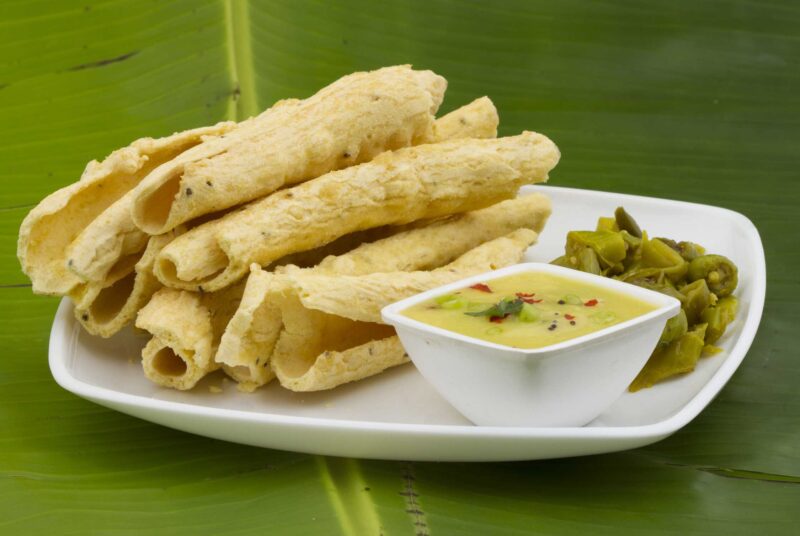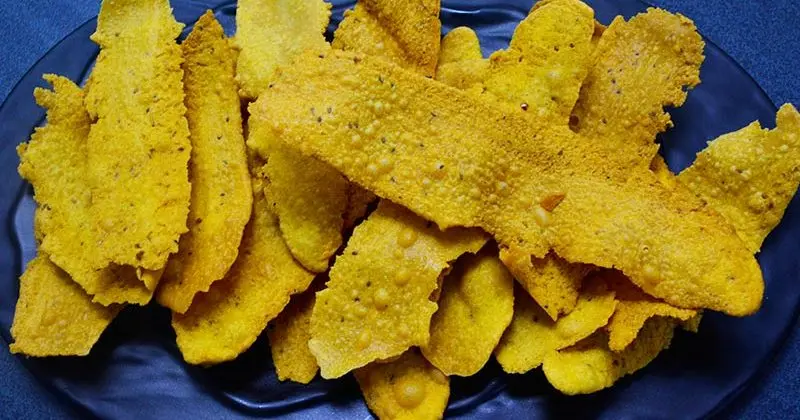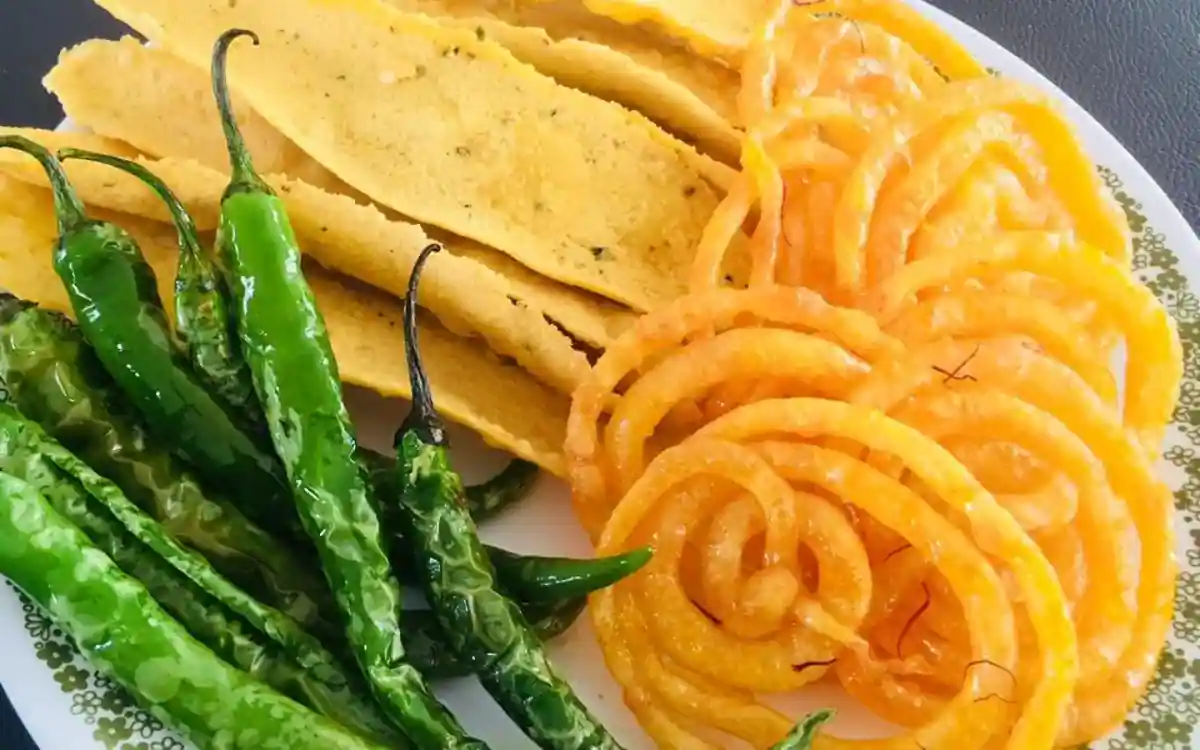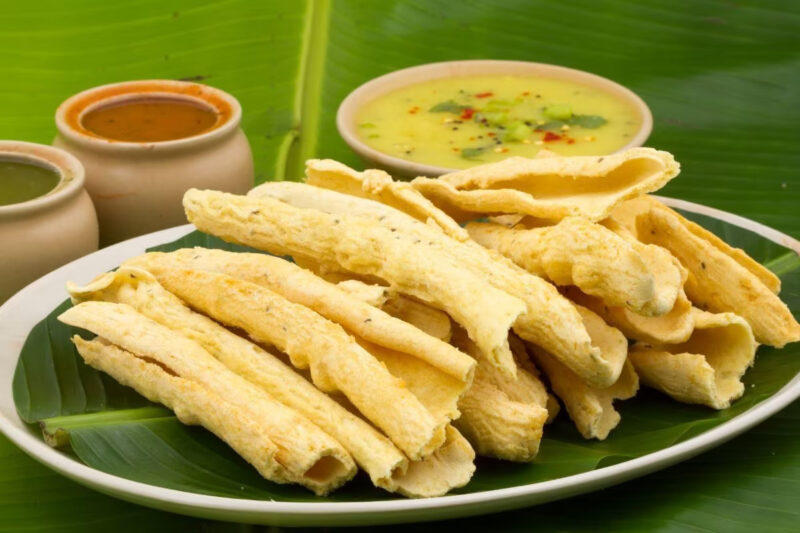Fafda Recipe: Fafda is a delectable fried snack made from gram flour (besan), seasoned with carom seeds and crushed black pepper. It’s a popular vegan treat originating from Gujarat, known for its addictive taste and crispy texture. This recipe ensures that the homemade fafda tastes just as delicious as the ones you find outside.
To serve, fafda pairs wonderfully with papaya sambharo and fried green chilies, offering a delightful breakfast or snack option. While traditionally enjoyed during the Dussehra festival with papaya chutney and jalebi, making them at home is simple and rewarding.

Fafda Recipe Ingredients:
- 1 cup gram flour (besan)
- ¼ teaspoon carom seeds (ajwain)
- 10 to 12 black peppercorns, crushed
- ¼ teaspoon turmeric powder
- 1 pinch asafoetida (hing)
- ⅛ teaspoon baking soda or 2 to 3 pinches baking soda
- 3 to 4 tablespoons water, or as needed
- 2 tablespoons oil
- ¾ teaspoon salt, or to taste
- Oil for deep frying

How to Make Fafda Recipe:
- Take 1 cup of gram flour (besan) in a bowl or large plate with rims.
- Add ¼ teaspoon of carom seeds (ajwain), 10 to 12 coarsely crushed black pepper, ¼ teaspoon of turmeric powder, and a pinch of asafoetida (hing). Also, add ⅛ teaspoon of baking soda or 2 to 3 pinches of baking soda.
- Mix the ingredients well using a spoon.
- Now, add ¾ teaspoon of salt or adjust according to taste.
- Gradually pour 2 to 3 tablespoons of water into the mixture in parts.
- Start mixing the water with the gram flour.
- Knead the mixture into a tight dough.
- Next, add 2 tablespoons of oil and continue kneading. Add more water if required. Initially, I added 3 tablespoons of water, and after adding oil, I added 1 more tablespoon of water. In total, I added 4 tablespoons of water. The amount of water needed may vary depending on the quality of the gram flour.
- Knead the dough until all the water is absorbed.
- Once the water is absorbed, the stickiness will disappear, and you’ll have a soft, smooth dough. Cover the dough and set it aside for 30 minutes to rest.

Rolling Fafda:
- After 30 minutes, divide the dough into small balls. Cover them with a lid or kitchen towel to prevent them from drying out.
- Lightly spread oil on a wooden board. Place one dough ball on the lightly greased surface. Avoid using too much oil on the board as it may make it difficult to press the dough. You can also apply some oil on your hands before starting the next step.
- Using the heels of your palms, gently press and flatten the dough ball while moving your palms forward. Apply consistent but light pressure. Be cautious not to exert too much force as it may cause the fafda to stick to the board and break when lifted. This step requires some skill and practice. Ensure the dough is not flattened too thinly, as it will be difficult to lift. You can also use a knife or spatula to lift the fafda.
- You will obtain long elongated shaped fafdas. Carefully lift them from the board. Avoid making them too thin as they may become fragile. Alternatively, you can roll out a large piece of dough with a rolling pin on a greased surface and cut it into strips with a knife.
- Place the rolled fafdas on a separate plate or board lightly greased with oil. Repeat the process with the remaining dough balls. Cover them with a kitchen napkin to prevent them from drying out.

Frying Fafda:
- Heat oil in a kadai. To check if the oil is ready, drop a small piece of dough into the oil. It should gradually rise to the surface.
- Once the oil reaches a medium-hot temperature, reduce the flame to low-medium. Carefully add the fafda pieces into the oil.
- Avoid overcrowding the kadai. Depending on its size, you can fry 3 to 4 pieces at a time.
- Begin frying over low-medium flame.
- When one side turns crisp and golden, gently flip each fafda using a slotted spoon and continue frying.
- Flip them again and fry until they are uniformly crisp. Avoid over-browning them. Fafda fries quickly, so keep a close eye on them.
- Once done, remove the fried fafdas using a slotted spoon, allowing excess oil to drain back into the kadai.
- Place the fried fafdas on kitchen paper towels to absorb any excess oil. Repeat the frying process with the remaining batches.
- Serve the fafdas warm or at room temperature with papaya sambharo, fafda chutney, or Gujarati Kadhi.

Nutrition Information (Approximate Values)
Amount Per Serving
- Calories: 88
- Calories from Fat: 54
- % Daily Value*
- Fat: 6g (9%)
- Sodium: 161mg (7%)
- Potassium: 75mg (2%)
- Carbohydrates: 5g (2%)
- Fiber: 1g (4%)
- Protein: 1g (2%)
- Vitamin A: 10IU (0%)
- Calcium: 7mg (1%)
- Iron: 0.5mg (3%)
*Percent Daily Values are based on a 2000 calorie diet.
Conclusion
In conclusion, Fafda Recipe is a beloved Gujarati snack cherished for its crispy texture and savory flavors. With simple ingredients and careful preparation, you can enjoy homemade Fafda that rivals the taste of those found in local eateries. Whether served during festivals or as a casual snack, Fafda delights the taste buds and adds a touch of tradition to any mealtime.
FAQs about Fafda Recipe
What is Fafda?
Fafda is a delectable fried snack made from gram flour (besan), seasoned with carom seeds and crushed black pepper. It’s a popular vegan treat originating from Gujarat, known for its addictive taste and crispy texture.
What are the key ingredients needed to make Fafda?
The main ingredients for making Fafda include gram flour (besan), carom seeds (ajwain), crushed black pepper, turmeric powder, asafoetida (hing), baking soda, water, oil for kneading, and oil for deep frying.
How do you roll and shape the Fafda dough?
After allowing the dough to rest, divide it into small balls. Lightly grease a wooden board and flatten each dough ball using the heels of your palms, moving them forward with gentle pressure. Ensure the dough is not too thin to prevent it from breaking while frying.
What is the best way to fry Fafda?
Heat oil in a kadai until it reaches a medium-hot temperature. Fry the flattened fafda pieces in batches over low-medium flame, ensuring they are evenly golden and crisp on both sides. Avoid overcrowding the kadai to maintain the oil temperature.
How should Fafda be served?
Fafda is best served warm or at room temperature with accompaniments such as papaya sambharo, fafda chutney, or Gujarati Kadhi. It makes for a delightful breakfast or snack option, enjoyed by itself or paired with fried green chilies for an extra kick.

